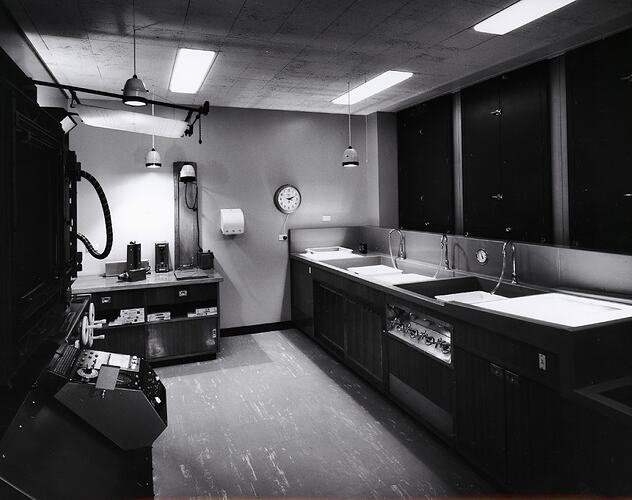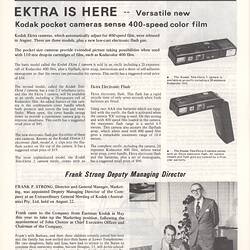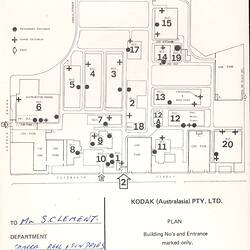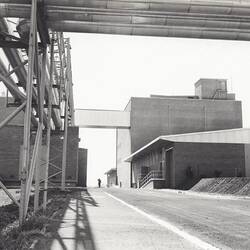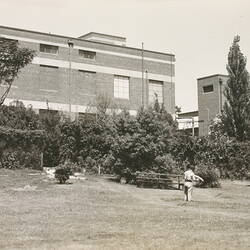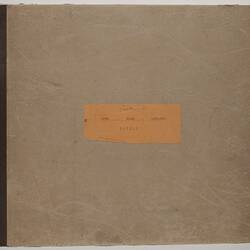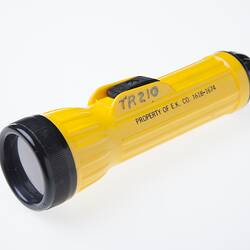Summary
Before the advent of digital photography, the making of a photographic image depended on the reaction of silver to light. Consequently it was crucial that light be excluded from the process of manufacturing photographic materials. This is how it was done at Kodak Australasia.
Before the advent of digital photography, the making of a photographic image depended on the reaction of silver to light. Consequently it was crucial that light be excluded from the process of manufacturing photographic materials. These were made by coating glass plates, film base and paper with light-sensitive emulsions containing silver. If the unexposed film came in contact with light before it was used in the camera, it could be spoilt. Similarly, it was essential that the development of photographs be free from light contamination. People working in the manufacture and developing of films at Kodak were therefore required to work in darkness.
The degree of darkness required depended on the product being made. Each type of light-sensitive material could tolerate a different type of 'safe lighting'. This was low-intensity lighting, fitted with coloured filters and placed at strategic points in the factory to give sufficient light for the safety of workers without shining directly on the product.
John Garrett, who worked at Kodak's Abbotsford factory in the 1930s and '40s recalls: 'If you were only using ordinary red lights, that wasn't too bad because you could walk in and within five minutes you could see quite well. Panchromatic green was totally different, it was so akin to being total darkness that you had to spend at least twenty minutes getting really used to it before you could walk round without walking into people and things.'
Another former Kodak employee Brian Phillipson, commented: 'When you first go into the darkroom you think, 'I'll give it away', because it's strange. It takes a while to get adapted to it. But once you settle down it's quite a good job, good people. And you got the same money in those days as what a tradesman would get, because you're working in the darkroom, so you're on good money.'
Although working in the film coating and developing rooms did not require trade qualifications, the workers became very skilled at their jobs, particularly in the first half of the twentieth century when there was little technology to assist them at Kodak's Abbotsford factory. A former Kodak director Ed Woods remembers one of the tasks, which involved watching and controlling temperature levels: 'You had to heat things up at three degrees a minute, it was important that you just did heat it up at three degrees a minute. We had operators who had a graph on a bit of graph paper and they had to vary the hot and cold solutions to keep the pointer going right on that line. The operators at Abbotsford were just so good they could do it almost blindfolded.'
Even guillotine operators worked in the dark, cutting up photographic papers and glass plates. John Garrett explains: 'We used to have hand cutting machines for cutting the glass down from say ten eights to five by fours. And this was a fairly heavy aluminium contraption, had a sliding arm. And you'd lay your plate on this, sitting in the total darkness if you had to, total dark. You'd pre-set your machine in the daylight outside the office - you can't just head to the workrooms into one of the dark rooms where you're doing the job - and you'd put the plate there, and you'd finish up with four plates.'
Safe and efficient working in the dark depended on everything being in the right place, plus and an awareness of safety, and there were few accidents resulting from the dark environment. When Kodak opened a new factory at Coburg in 1961, modern equipment was installed, which made working in the dark easier.
Kodak's film coating and processing operations provided employment opportunities for blind workers. Several returned soldiers who had lost their eyesight serving in World War II worked in the film coating department at Abbotsford.
Ron Hooper, who worked in Kodak's dark room in the 1970s and 1980s, was able to use his heightened sense of touch to save any films that went into the wrong processing line by mistake. He could tell the difference between Kodacolor - the film used for prints - and Kodachrome - the film used for slides - by feeling the texture. The photographs would have been ruined if they had been put into the wrong developing solution.
Brian Phillipson worked with blind workers when doing trials of film coating for quality control: 'They were a lot better than me in the dark, I can tell you. But you had to have everything in situ for them; whatever they had to handle was put in certain positions. One of them had a guide dog, and when we got our meals - we ate in the coating track dining room - the dog had a meal too.'
Brian Phillipson remembers a saying in the darkroom: 'It might be dark but it's never dull'. In paper coating we used to make animated signs, something funny like a bloke stuck in a guillotine, and they were inserted into the safe light for the guillotine room.'
No doubt this reminded workers to take care.
References
Kodak Australasia Pty Ltd, 'A Visit to the Kodak Laboratories', Abbotsford, c.1940 (HT 20721).
John Garrett, interviewed by Lesley Alves, 1 May 2014
Ron Hooper, unrecorded interview by Lesley Alves 26 September 2013
Brian Phillipson, interviewed by Lesley Alves, 8 January 2014
Ed Woods and John Mitcham, interviewed by Fiona Kinsey, 21 April 2009.
More Information
-
Keywords
Factories, Occupational Health & Safety, Safety Equipment, Manufacturing
-
Authors
-
Article types
